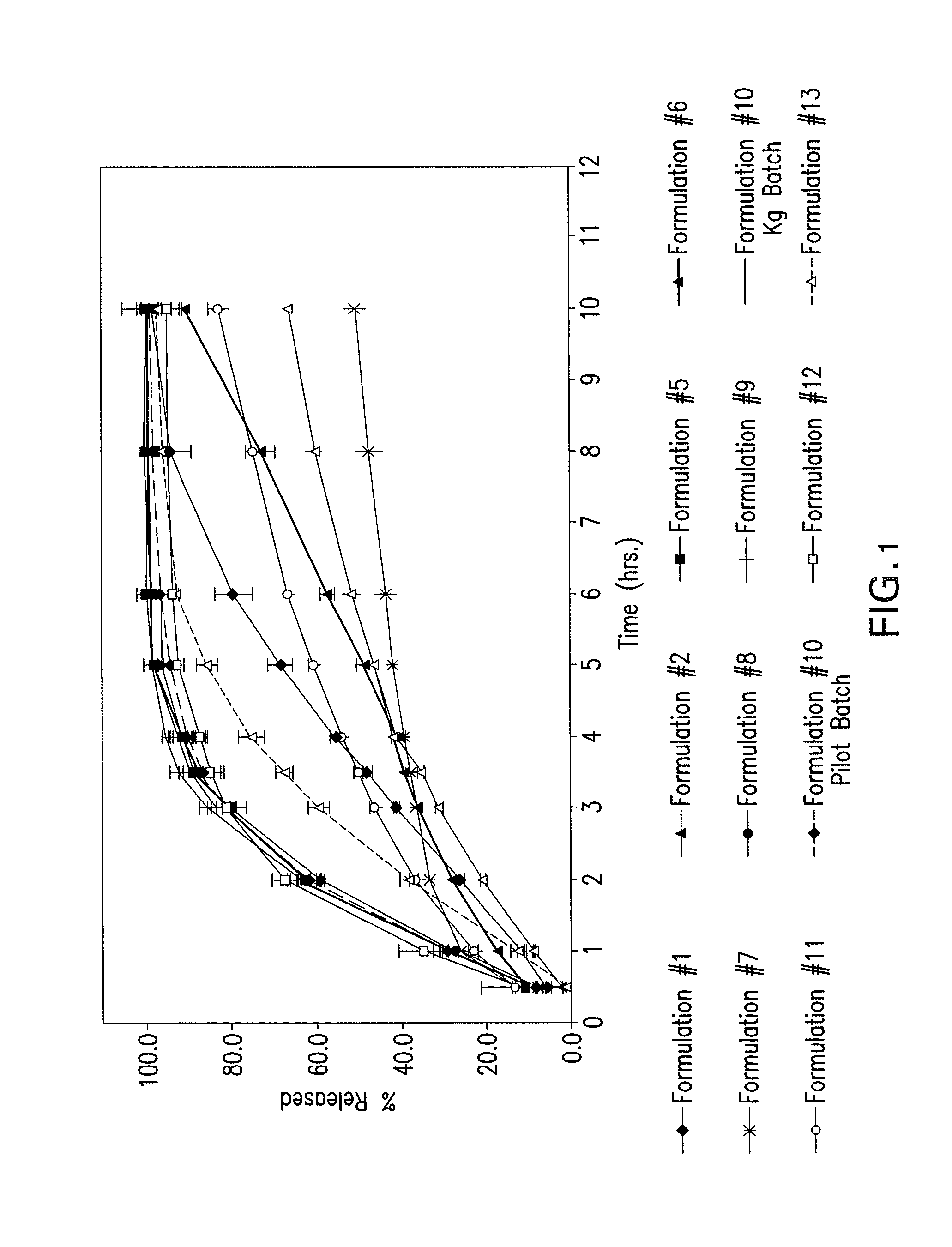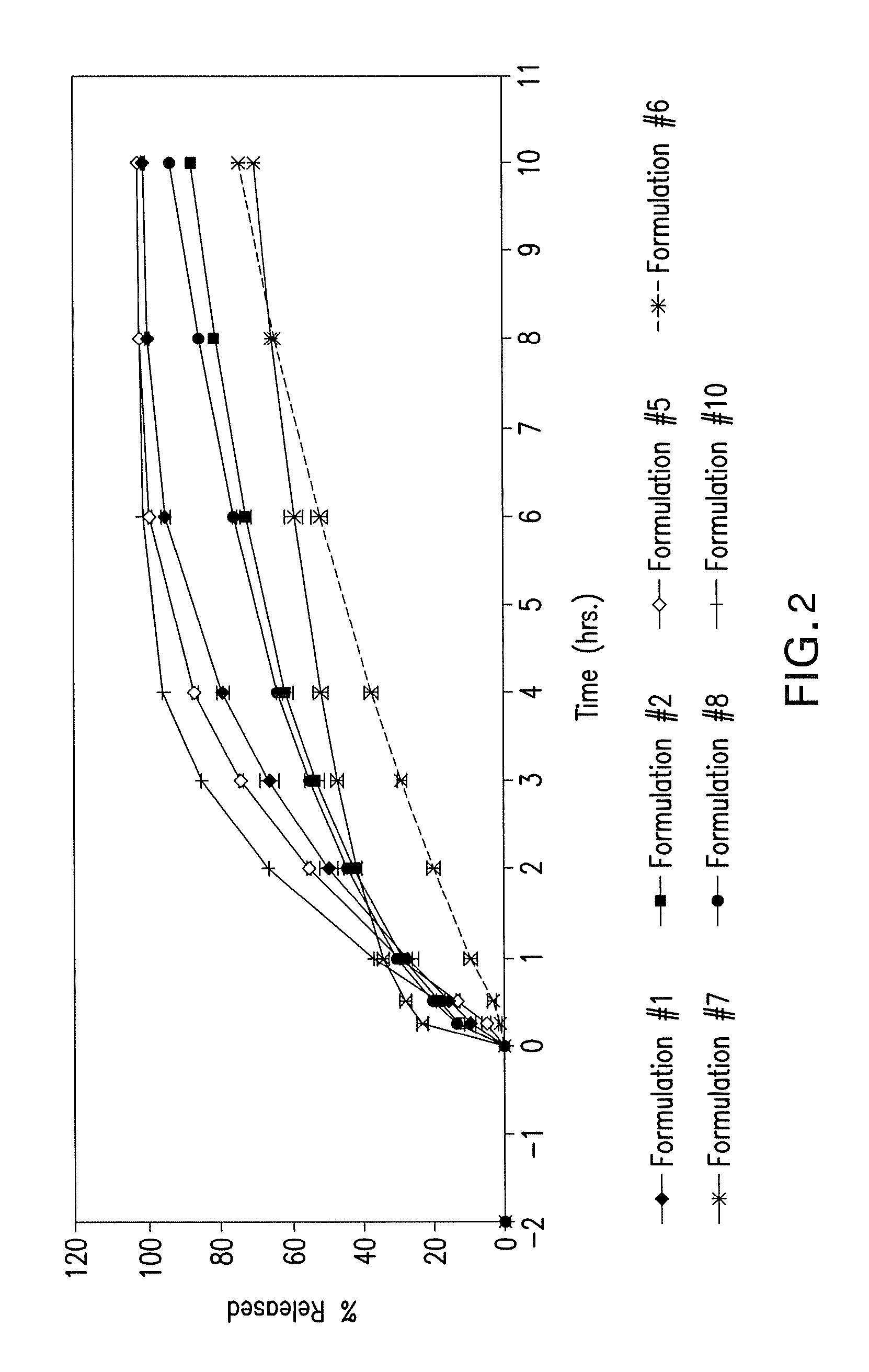Pharmaceutical formulations
a technology of pharmaceutical formulations and dosage forms, applied in the direction of drug compositions, extracellular fluid disorders, metabolic disorders, etc., can solve the problems of low bioavailability of these compounds (i.e., their absorption in the digestive tract), undesirable food effects, and low bioavailability of compounds, so as to achieve the effect of modulating hydrophilicity and/or hydrophobicity
- Summary
- Abstract
- Description
- Claims
- Application Information
AI Technical Summary
Benefits of technology
Problems solved by technology
Method used
Image
Examples
example 1
Pharmaceutical Formulations
[0147]The following formulations were prepared and tested in vitro and as well as in healthy human subjects: (a) three mini-tablet formulations (each having no enteric coating) containing 2-[4-(4-chlorobenzoyl)phenoxy]-2-methyl-propanoic acid (Formulations 1, 2, and 8); (b) six (6) enteric coated mini-tablet formulations containing choline salt of 2-[4-(4-chlorobenzoyl)phenoxy]-2-methyl-propanoic acid (Formulation 5 and 9-13); (c) single-unit enteric coated tablet containing choline salt of 2-[4-(4-chlorobenzoyl)phenoxy]-2-methyl-propanoic acid (Formulation 6); and (d) coated granules containing 2-[4-(4-chlorobenzoyl)phenoxy]-2-methyl-propanoic acid in capsules (Formulation 7).
[0148]Formulations 3 and 4 (containing a choline salt of 2-[4-(4-chlorobenzoyl)phenoxy]-2-methyl-propanoic acid) were prepared, tested in vitro, but not tested in human subjects. Specifically, Formulation 3 was a single unit HPMC-based tablet that was uncoated. Formulation 4 was a co...
example 2
Dissolution Methods
[0152]The dissolution data from Formulations 1-2 and 5-13 as described in Example 1 was collected and is depicted in FIG. 2 using the single pH method. In FIG. 1, Formulation 10 is shown twice. Formulation #10 depicted with the solid line (in between the legend for Formulation #9 and Formulation #11) was made in a Kg batch pursuant to the methods described in Example 1. Formulation #10 depicted with the dashed line with the diamond (—♦—) (in between the legend for Formulation #11 and Formulation #12) was made in a pilot batch pursuant to the methods described in Example 1. Formulations 1-2, 5-9 and 11-13 were made in a Kg batch pursuant to the methods described in Example 1, while Formulation 6 was manufactured in a batch size of approximately 10 kg.
[0153]The dissolution data from Formulations 1-2 and 5-13 as described in Example 1 was collected and is depicted in FIG. 2 using the dual pH method.
example 3
Human Biostudies
[0154]The purpose of the studies described in Examples 4, 5, 6 and 7 was to determine the bioavailability of the Formulations 1-2 and 5-13. These utilized a Phase 1, single-dose, open-label study conducted according to a crossover design. The number of subjects varied from study to study. The number of subjects that entered the studies and completed at least a portion of the studies is noted in each of the examples described herein. Subjects entered the study and were assigned to receive one of the following regimens in each study period: (1) the Reference; (2) a test Formulation under high fat fed conditions; or (3) a test Formulation under fasting conditions. The sequences of regimens were such that a pre-determined number of subjects received all of the regimens upon completion of the study, while others received part of the regimes. A washout interval of typically about 14 days separated the dosing in two (2) consecutive periods. Adult male and female subjects in...
PUM
| Property | Measurement | Unit |
|---|---|---|
| pH | aaaaa | aaaaa |
| pharmaceutical composition | aaaaa | aaaaa |
| pH | aaaaa | aaaaa |
Abstract
Description
Claims
Application Information
 Login to View More
Login to View More - R&D
- Intellectual Property
- Life Sciences
- Materials
- Tech Scout
- Unparalleled Data Quality
- Higher Quality Content
- 60% Fewer Hallucinations
Browse by: Latest US Patents, China's latest patents, Technical Efficacy Thesaurus, Application Domain, Technology Topic, Popular Technical Reports.
© 2025 PatSnap. All rights reserved.Legal|Privacy policy|Modern Slavery Act Transparency Statement|Sitemap|About US| Contact US: help@patsnap.com


